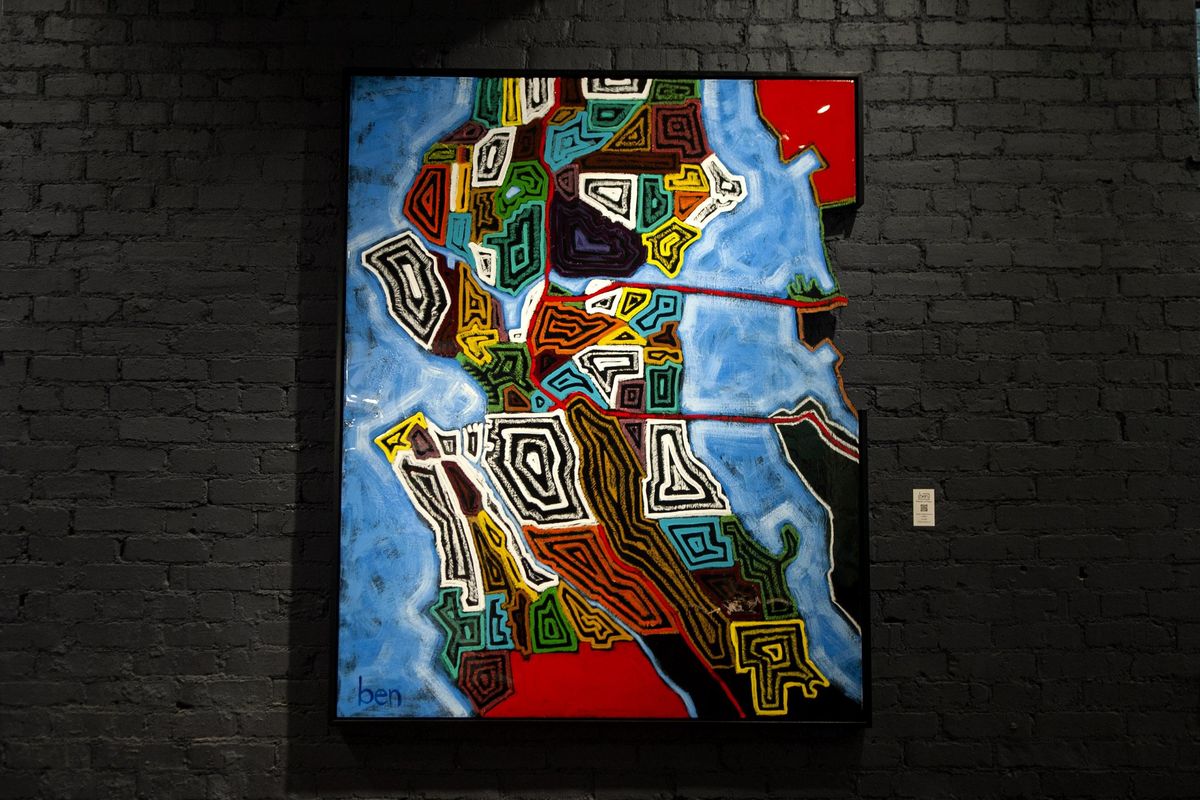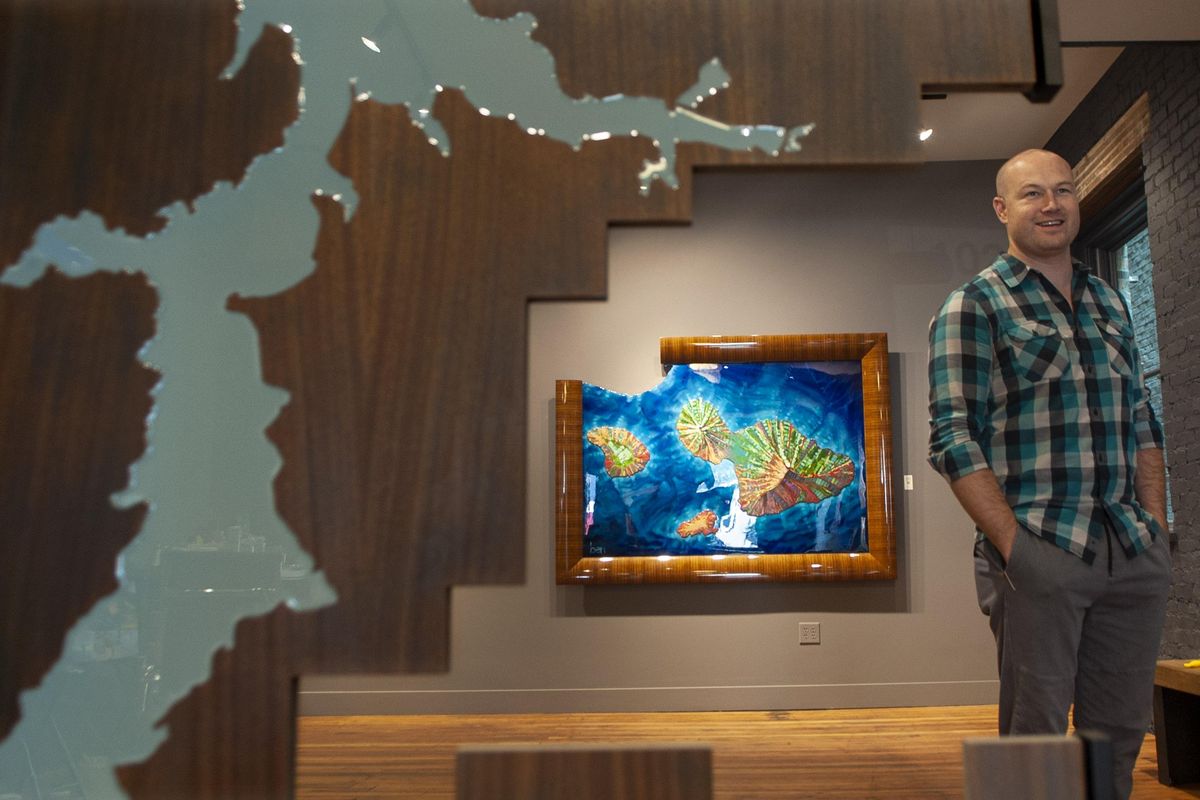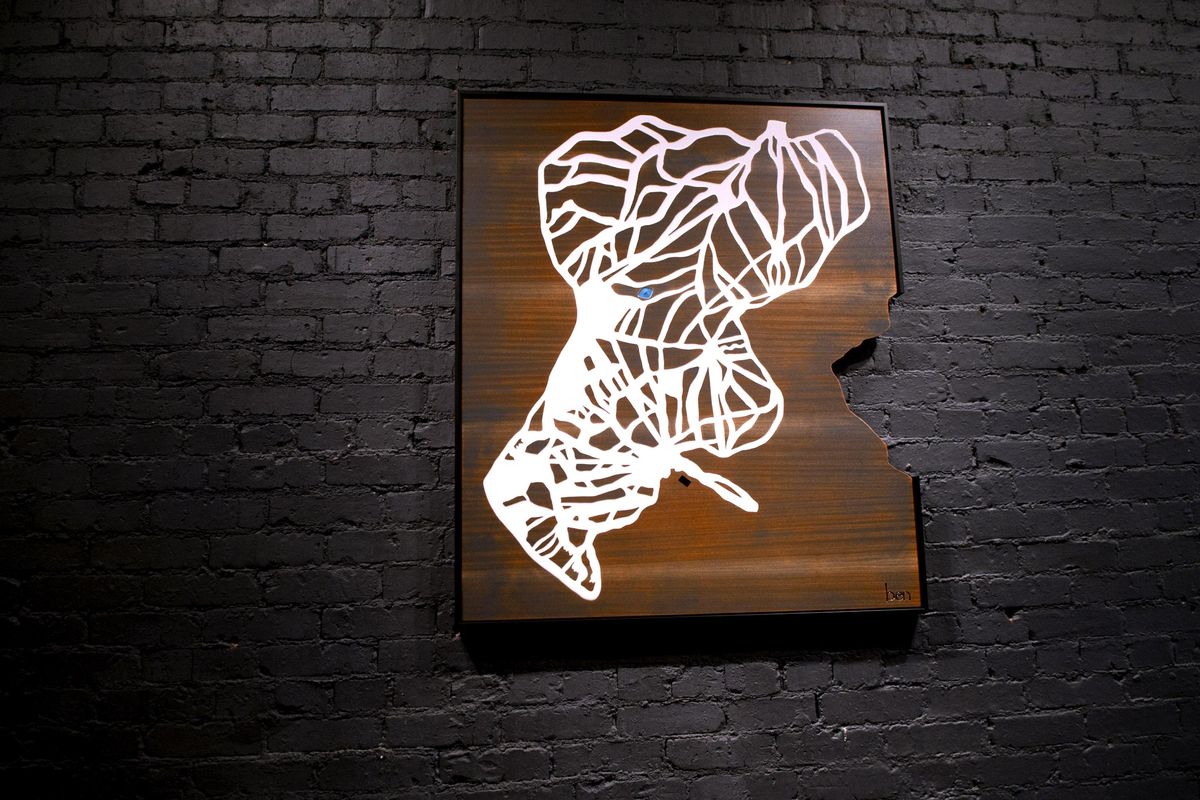Joyce’s perspective: Spokane artist continues to map his own path
Artist Ben Joyce is framed through Lake Coeur d’Alene with Maui in the background at his studio in Spokane on Friday, Aug. 24, 2018. (Kathy Plonka / The Spokesman-Review)Buy a print of this photo
Spokane-based artist Ben Joyce, 40, paused inside his loftlike gallery, nestled in the downtown alley behind Scratch and Rain, to observe a huge canvas he was recently compelled to paint. He had to cease work briefly on everything – the corporate and private commissions, the art festivals, the new studio plans – to get this image out of his brain.
Instead of one of his trademark pieces depicting a geographic landscape from a bird’s eye view, the image was of an actual, living animal: A menacing bull ready to charge right out of the canvas, glaring at the viewer, lit by a fire glowing within.
“Every once in a while I get these visions, and it puts me in a standstill and I think: ‘I need to put this out of my mind before I can continue,’ ” Joyce said. “It recharges the whole creative process.”
The bull painting is a stunner, taking up nearly the whole wall. It’s also a reminder that Joyce is versatile, an artist at the top of his game, ready to take on the world. Or at least to paint a heck of a lot of it.
Painting the world is what Joyce typically does. His depictions of the planet’s beloved places are not landscapes filled with rolling hills and sun-baked villas. Joyce takes the long view, literally. His signature pieces are rendered from an aerial perspective, with boundary lines and familiar bodies of water laid out in a map-like manner. But Joyce’s maps are different, seemingly created by an alien or some other magical being who doesn’t perceive the world like the rest of us.
Within this one conceit, the aerial perspective, Joyce journeys through the world of fine art. Sometimes he is impressionistic, other times he drips and splatters like Jackson Pollock, spray-paints lively graffiti like Banksy, goes spare and monochromatic, or chooses to build up colorful layers with a trowel. He works with acrylics, oils, gels, watercolors, resins, stains, burlap and more. In recent years, he has branched out into wood cuts of places, with acrylic gels poured into crevasses to form fascinating, reflecting bodies of water. All of his frames are broken on at least one side or corner, as if the earth’s landscapes cannot be confined to a rectangle or square.
The self-dubbed “Painter of Place” – yes, it’s trademarked – even crafted his own phrase to describe his style: “Abstract Topophilia.” Joyce seized on the word “topophilia,” meaning love of place, after his writer friend Terry Lawhead once used it to describe the artist’s drive to help viewers forge connections to place.
“There’s a lot of times where I kind of feel more like a messenger than an artist,” Joyce said. “My work allows individuals to connect to their place. It gives them a chance to relive it. To experience the feelings that come from their love of place.”
The place Joyce comes from is Acton, California, a small desert town where his parents ran three local weekly newspapers and raised eight children, instilling a rigorous work ethic. Joyce played high school football at a small parochial school “to escape some of the work,” he joked. He developed a talent for drawing and painting landscapes, meticulously rendering each blade of grass and mountain shade. He could already sell his pieces as a young man. But when he attended Southwestern College in San Diego, he got serious about making a living, majoring in architecture and playing more football.
“I got kind of burned out on both,” Joyce said.
Joyce transferred to Gonzaga University, which led to him to another seminal place in his life: Florence, Italy. As a 19-year-old waking up to the importance of art, Joyce became obsessed with capturing the beauty of place.
“As I’m painting these Italian landscapes, I’m looking to the sides of the canvas and behind me, and I’m listening and smelling and experiencing all this stuff,” Joyce said. “I’m thinking: ‘How can I create a landscape in which you can experience all of this in one piece as opposed to just from one perspective?’ ”
After he graduated from Gonzaga with a degree in art, Joyce returned to San Diego and landed a job working on computers. Despite the steady paycheck, he was miserable. His wife urged him to move back to Spokane, where she was from, and take a crack at being a full-time artist. In bed with his wife one night, staring at the uneven ceiling of their irregular-sized bedroom, he felt upside down. In a good way.
“It felt like I was looking down on the cityscape, and so all of a sudden now, you can see, to a degree, what’s behind that, and so I thought, ‘That’s it!’ ” Joyce said. “If I paint from a bird’s eye vantage point, then that’s when people can reconnect and re-infuse these pieces with their own connections and histories. It was literally like a split second revelation.”
Joyce completed his first aerial landscape of Spokane later that day. He eventually put together a show for a restaurant, started showing regularly at Barrister Winery, and hit the art festival circuit. It’s been steady work ever since.
A short stroll around Joyce’s gallery is like a walk through hundreds of miles of familiar neighborhoods. Without reading titles, one can recognize lakes Pend Oreille and Hayden; every San Francisco Bay Area neighborhood with little Alcatraz floating by the Golden Gate Bridge; the islands of Maui, Manhattan and San Juan. There’s the floating green at Coeur d’Alene Resort and all of Schweitzer Mountain’s white trails of snow, carved and painted into wood.
How can such a standoff-ish view – hundreds of miles in the air with nary a house, nor a hiker, nor a tree in sight – instill such pride of place?
“I am not trying to recreate your life,” Joyce said. “I’ll do commissions – with personal connection points in it … But I’m just giving you lines that you can connect with, and you can tell me what life is in that piece.”
There’s no doubt that Joyce’s works have struck a chord with lovers of art and place. One wall of his gallery is currently dedicated to Joyce’s unfinished painting of the whole world and its ocean currents, a massive commission for a California collector. Commissions take up the lion’s share of Joyce’s time. They can range from $5,000 to $85,000. More affordable “artist editions” of Joyce’s works – not the originals – are available on his website, ranging from $75 to $4,500.
Coming up with the system to properly craft and sell the more affordable editions of his works took two years. “The whole point of the limited editions is to give more people that fine art look on their wall that they can connect with and be proud of where they are,” he said.
Being in the right place has its perks. Take for example the time in 2010 when four 20-something guys in flip-flops wandered into Joyce’s booth at an art festival in Sausalito, California.
“I was talking to these guys and I see in the background this couple, dressed to the nines, looking at the work and giving me eye contact, but this group of guys wouldn’t let me go, and so the well-dressed couple eventually left,” Joyce said. “I thought: ‘That’s it. I blew it.’ ”
Five minutes later, the four guys broke the news that they were Google executives, they loved his stuff and they were in a buying mood. Since then Joyce has become one of Google headquarters’ favorite artists, with about 20 pieces in constant rotation and new ones commissioned every six months. That coveted placement has led to a lot of private commissions over the past eight years. Google Earth’s inventor hired Joyce to make three pieces for his personal residence in Lawrence, Kansas, which happens to be the default center point of Google Earth.
Celebrities such as John Travolta, the rap artist The Game and Metallica guitarist Kirk Hammett also have collected Joyce’s abstract topophilia. His public commissions include the 75-foot piece of the Spokane River in the Spokane Convention Center and 36 separate 5-by-8-foot pieces depicting the topography of Southern Nevada that are installed outside 18 Las Vegas transit stations.
The next frontier for Joyce centers around his plans to open a production studio, art gallery and event space to be named Ben Joyce Studios. He purchased the 7,000-square-foot building at 806 W. Third Ave. in July and plans to open this fall.
Joyce’s ambitious vision includes an idea he has been mulling for years: producing what he described as “a world art project connecting cultures across the globe.” Joyce declined to give specifics, mainly because “there are still a lot of unknowns,” but he said a documentary-like project “is absolutely going to happen.”
One Anthony Bourdain-inspired concept could include a camera crew that follows Joyce as he travels to far-flung places to interview local people from different cultures. The current idea is to document how Joyce then takes that knowledge and inspiration back to his studio to create his work.
The project stems from Joyce’s desire to create what he calls “The Place Collection,” eight or 12 pieces that he wants to produce in a way that has never been seen before.
“I want to create this collection to get people to take a step back and breathe, to allow them to connect for a second,” Joyce said. “I want people to feel good that they live in a great place.”



